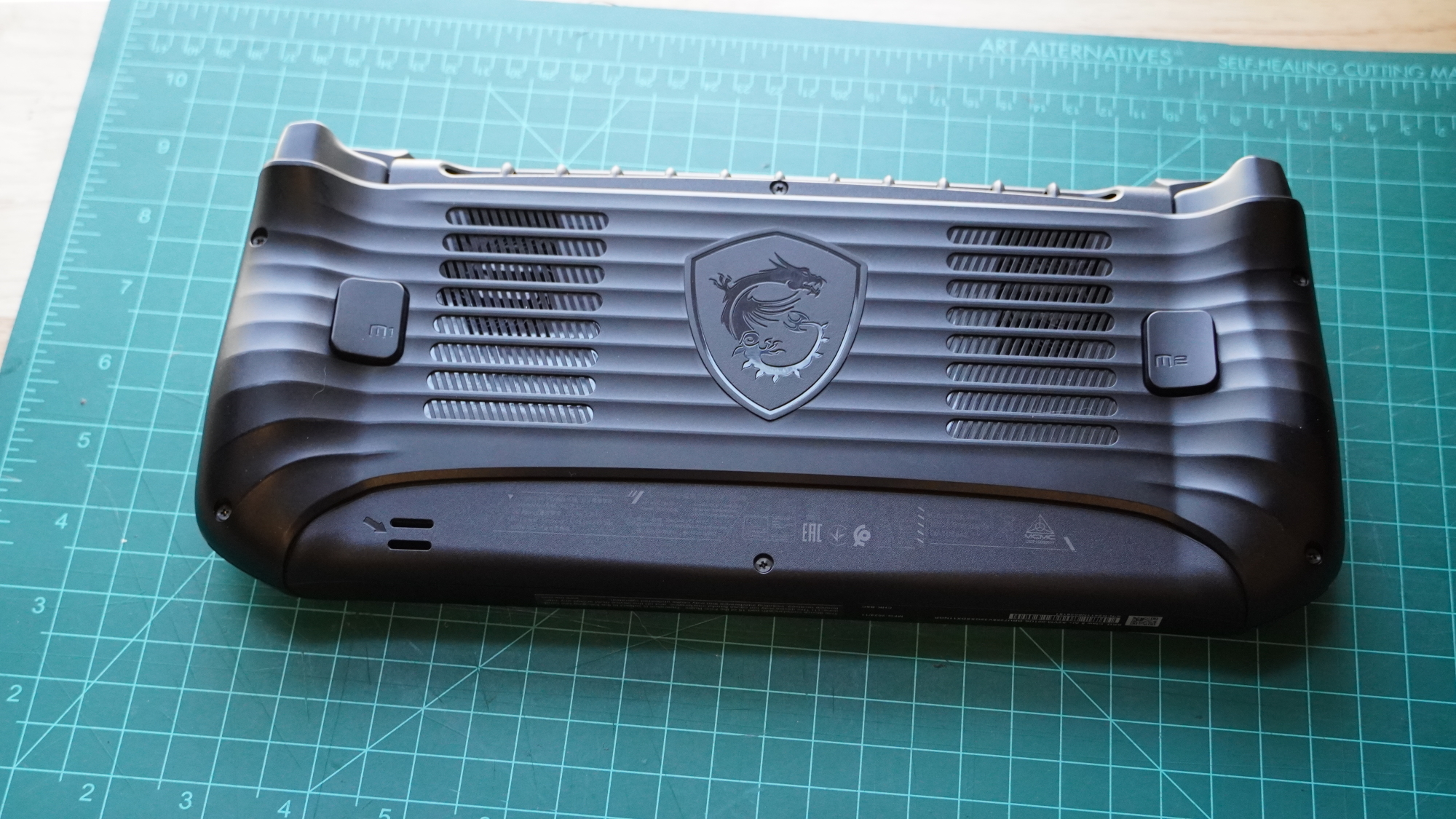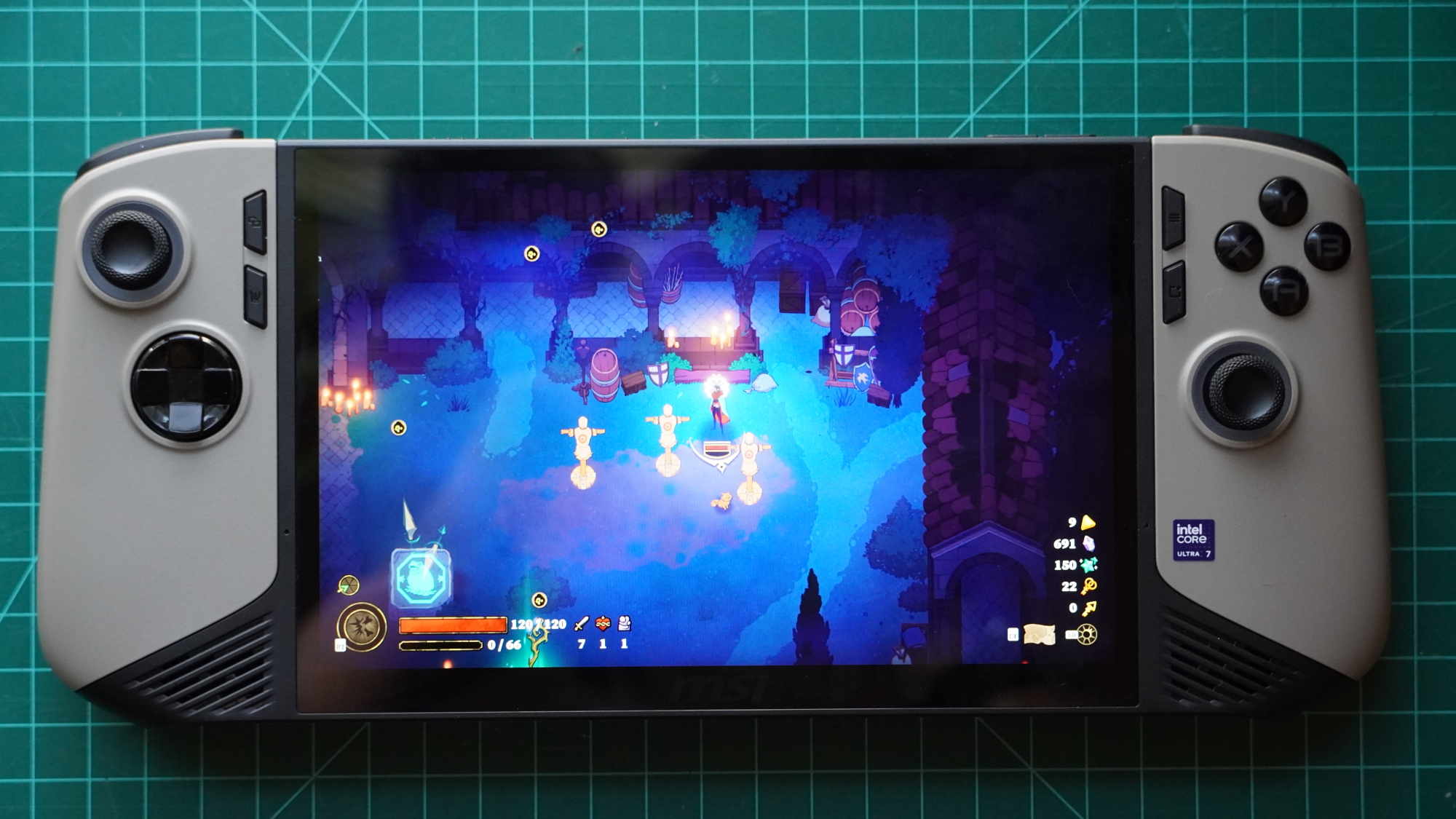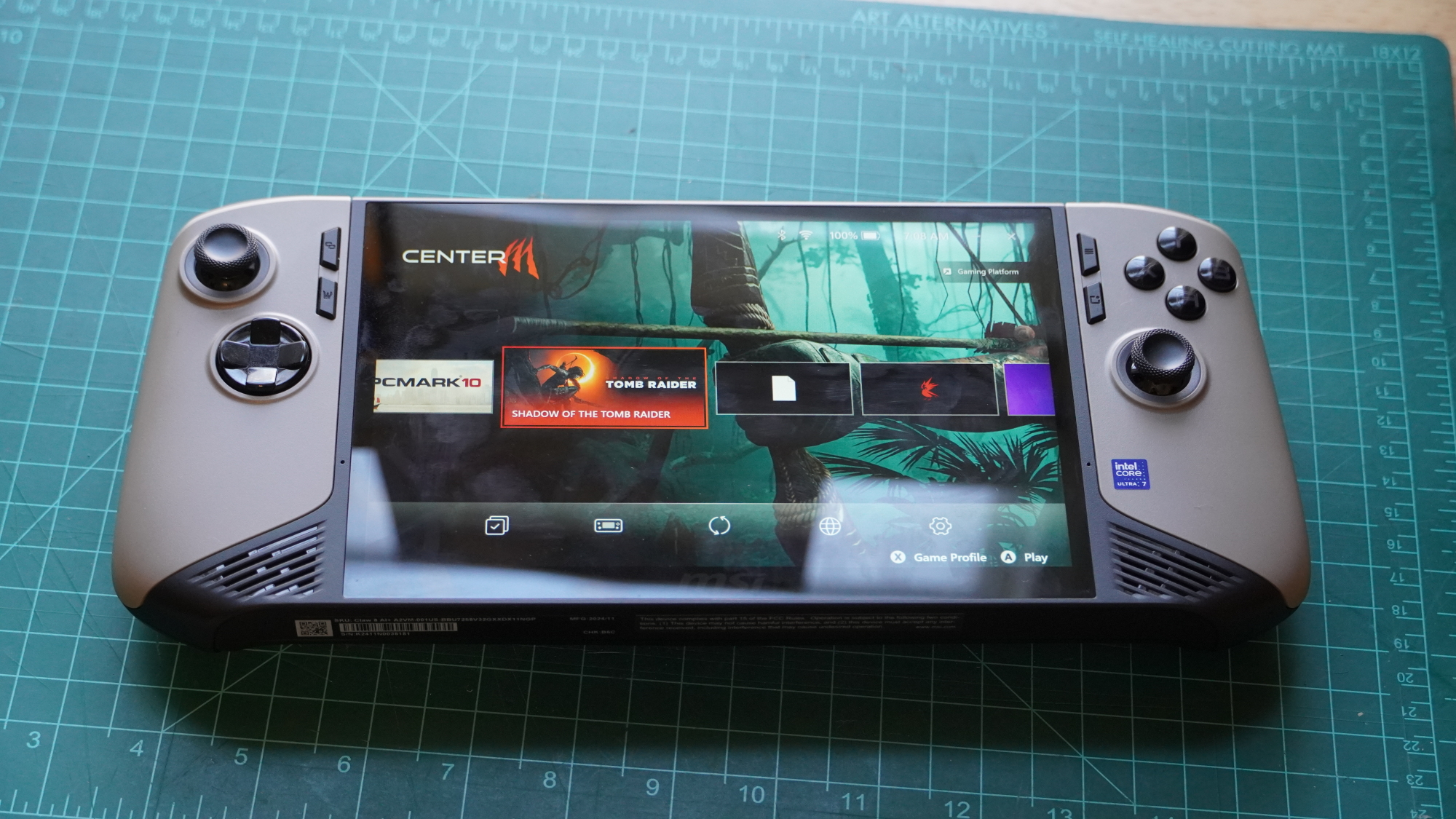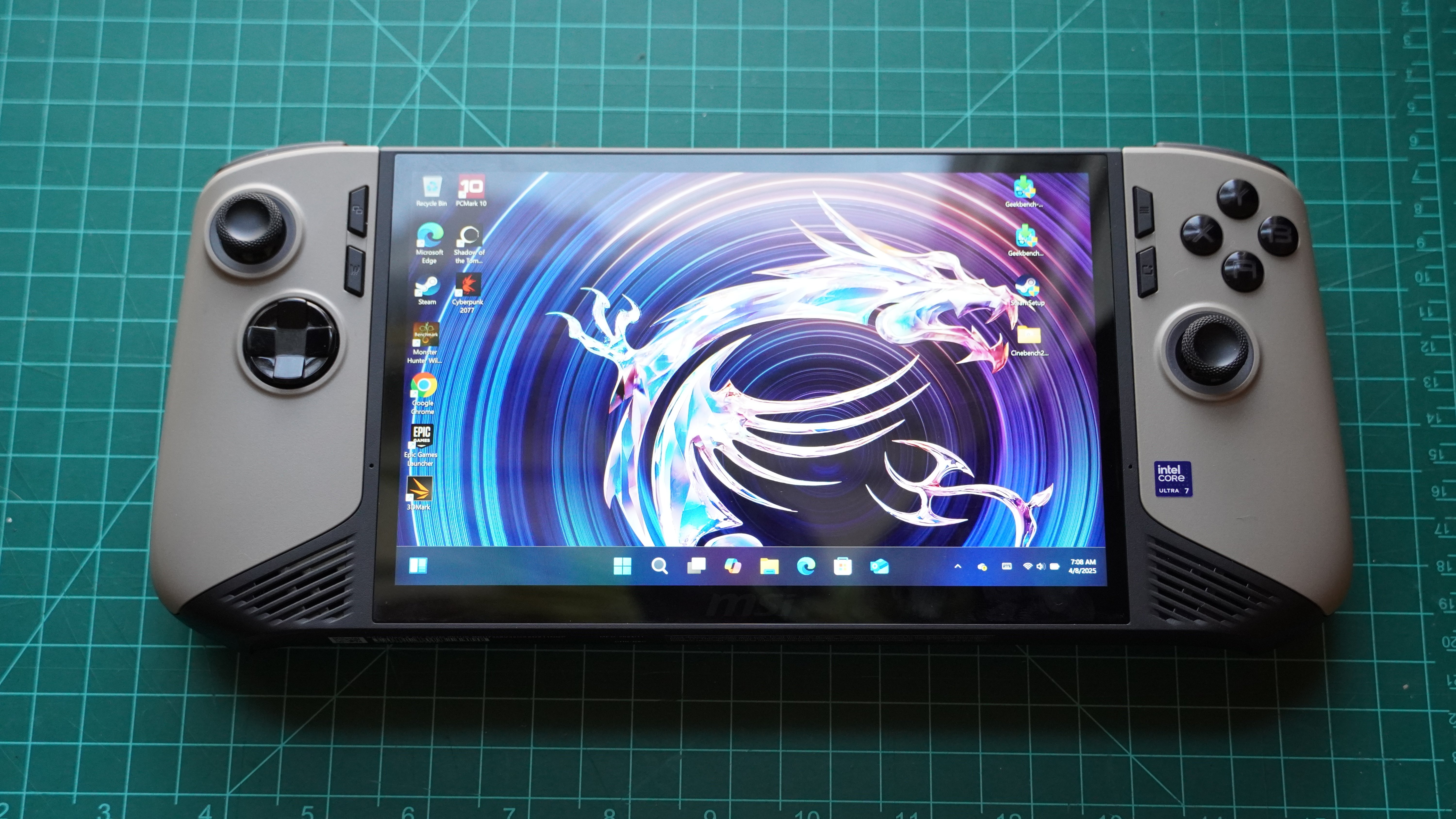The MSI Claw 8 AI+ Can't Keep Up With Laptops, but It's Priced Like One
-
The Good
- Potent for a handheld
- Bright, contrasty display and rich audio
- Support for many game libraries
The Bad- Thumbstick layout a little awkward
- Expensive for a handheld
- MSI still has software kinks to work out
Table of Contents
The MSI Claw 8 AI+ is a bold addition to the PC gaming handheld market. It bumps up some of the specs of the original, notably with a bigger display, and it jumps up in size a bit, too. It kicks off with a steeper starting price of $899 as well, setting itself apart considerably from the likes of the Steam Deck and even moving up from the popular Asus ROG Ally X. To justify this price hike, it packs in a potent Intel Core 7 Ultra 258V chip, which has one of the better integrated GPUs on the market, plus 1TB of storage and 32GB of memory. It also boasts a large, sharp, and bright display.
But while it’s certainly strong for a handheld, it remains limited by that iGPU. Playing big, AAA games without some serious cuts to visual fidelity—which, in some cases, can get bad enough to ruin your experience—is still not in the cards for this system. It’ll run indie games well enough, but so do its handheld rivals. And at $899, it will really make shoppers consider whether a more powerful gaming laptop with a discrete GPU will work for them instead. If you absolutely need the most performance in the portable design of a handheld, then go for it, but the alternatives make a lot more sense.
Not the most wieldy for a handheld
The original MSI Claw was already a decently sizable gaming handheld at 0.8 by 11.5 by 4.6 inches and 1.48 pounds. It was comparable to a Steam Deck OLED, albeit slightly heavier. The MSI Claw 8 AI+ steps the size up even further. It’s now wider at 11.77 inches, taller at 4.96 inches, and it’s nearly an inch thick at its middle. Because of its side grips, it ends up standing almost 1.5 inches tall. All that extra size comes with some extra weight, too, with the MSI Claw 8 AI+ hitting 1.75 pounds.
The extra space does provide for a nice, big 8-inch screen, and the extra width isn’t a detriment to ergonomics. But the weight can make it a bit uncomfortable to hold up unsupported for long. It’s rather bottom-heavy, though, so it’s comfortable to hold up while resting the lower edge on a table or some other surface.
The device is all plastic but doesn’t feel too cheaply built, apart from some weaker plastic around the back. That’s where you’ll find two intake vents cleverly placed to avoid users’ hands or getting covered when setting the MSI Claw 8 AI+ down. With heat jetting out the top, the MSI Claw 8 AI+ avoids getting very hot in use, and the handgrips never felt very warm in my testing.

Each side has rounded and ribbed grips that offer a decent place to put your hands. For larger hands, they could stand to be bigger, as they don’t give quite as much grip as a modern Xbox or PlayStation controller. MSI’s control layout may not be ideal for frequent switching between control styles, though. The buttons and D-Pad are offset from the joysticks almost vertically. This makes switching between them difficult, as it can take more than simply shifting your thumb over to reach them. Rather, it may involve sliding your hand up and down. I didn’t find it overly uncomfortable, but if I played a game that involved frequent switching between these controls, it may have proved more problematic.
At least the controls are of decent quality. MSI has included Hall Effect triggers and joysticks here, which are quite nuanced in their input and should avoid issues with stick drift. The main buttons and shoulder buttons have a nice pop to them, too, though I wouldn’t put them on the level of the micro-switch buttons I’ve seen in devices like the Turtle Beach Stealth Ultra controller. At least they’re not too mushy. MSI also complements the more standard controls with two rear buttons that are firm enough to avoid accidental presses but otherwise easy to access.
The MSI Claw 8 AI+ also supports gyroscopic controls, which can be set to simulate either mouse movements or either left or right joystick inputs. Despite toying with different modes and settings for this gyroscopic control, I found I couldn’t get it to provide very fine-tuned control. While I’ve used gyroscopic aiming extensively on the Nintendo Switch to aim in Legend of Zelda: Breath of the Wild, the Claw was no match — no headshots for me.
Since gaming controls aren’t so ideal for navigating Windows, the Claw 8 AI+ also has a touchscreen. It doesn’t feel great to tap, with a slightly soft, hollow feeling to it. But it gets the job done.
The Claw 8 AI+ isn’t the most stylish device. Its combination of black and gray plastics give it something of a utilitarian vibe. There are RGB lights around the joysticks and red lights inside of the ABXY buttons, but that’s about it.
MSI might have done more for portability, too, like including a face cover to protect the screen and controls. The device also lacks a kickstand that could have helped hold it up. The box it comes in has a section of cardboard meant to be repurposed into a stand, but that’s a small consolation for a device that could have had one built in.

There’s a good smattering of I/O along the top edge of the Claw 8 AI+. The device offers two Thunderbolt 4 ports, allowing it to run with a dock for desktop use or use a peripheral while also charging. You can also expand your storage with a microSD card in a slot near those ports. And you can plug in a wired headset with the 3.5mm jack, which I think would have been better positioned at the bottom of the device. Rounding out the claw, there's also dedicated volume controls on the top edge of the device.
Solid sights and sounds
MSI packed in a great little display for the Claw 8 AI+. At 8 inches and with thin bezels, it takes up more space than on the Steam Deck, providing a clear view of games. It also uses a 16:10 aspect ratio to go slightly beyond 1080p for 1,920 x 1,200 instead. It’ll run at up to 120Hz for smooth visuals, though VRR will help avoid issues when the system is unable to supply 120fps gameplay. The screen gets plenty bright, reaching slightly over 500 nits in my measurements, and the display is capable of a contrast ratio of nearly 1500:1.
The display isn’t perfect, though. It is glossy, and thus can suffer from reflections. It also has limited viewing angles, with visual quality dropping quickly if you view it from too much of an angle. These two problems combines can occasionally make it hard to find a good angle to hold the device at.
You’ll get to enjoy a solid dose of sound from the MSI Claw 8 AI+. It features dual two-watt speakers like its predecessor. These are situated behind small grilles at the front of the device. They provide a surprising amount of volume and will be too loud for prolonged listening at full volume. The speakers pump out some bass to keep music and game sound effects sounding plenty heavy, and they don’t distort at high volume levels.

A cut above the competition, but no match for a dGPU
The MSI Claw 8 AI+ has performance that fits the bill, but it will leave you craving more if you think you’re getting a gaming PC or console all packed into a small handheld. This little system relies on the Intel Core Ultra 7 258V and its integrated Arc graphics. That’s a potent enough CPU and an exceptional integrated GPU, but it’s really no match for a discrete graphics processor (what you’d find in most gaming laptops).
The choice of CPU here also doesn’t provide much of a performance upgrade for actual CPU-centered tasks, as my experience with the Intel Core Ultra 7 258V is that it’s no faster than the Intel Core Ultra 7 155H found in MSI’s earlier model (and countless laptops). But the newer chip's efficiency and iGPU are crucial for gaming, and my benchmarks show the new MSI Claw 8 AI+ stepping up.
Compared to the original MSI Claw’s benchmark results at PCMag, the new model boosted performance considerably in 3DMark’s Time Spy and Night Raid tests. PCMag also saw just 33fps running Cyberpunk 2077 on the original Claw using the Steam Deck settings preset (which relies on AMD’s FSR and a 720p resolution). While not an exact 1:1 match, I ran the MSI Claw 8 AI+ using the Steam Deck preset and the more-appropriate Intel XeSS in Balanced mode and saw the new Claw achieve 77.5 fps on average.
That’s not to say that the MSI Claw 8 AI+ is a beast ready for whatever you throw at it. Even bumping the resolution for Cyberpunk 2077 to 1080p while leaving all other settings unchanged, performance dropped dramatically down to 29.5 fps. Getting the most performance out of the handheld also requires dialing up the power draw. You can manually set it to run at 30 watts or let MSI manage the power with its AI Engine. I had mixed results with the AI engine, seeing it often fail to deliver as much performance as simply letting the Claw max out at 30 watts.
The truth is that plenty of games will be simply too demanding for the device. The recently launched Monster Hunter Wilds, for instance, was too heavy for the system to handle well. No matter which settings I enabled, the handheld struggled to run the game smoothly. At 1080p with the Lowest graphics settings, XeSS Balanced, and the system running at its full 30-watt mode, it just eked out a 32.98 fps average and had severe stutter. Even with MSI’s recommended settings for hitting 50fps — a rather light 720p, Low settings, FSR Ultra Performance (an odd recommendation for an Intel iGPU that should be using XeSS) — the system managed only an average of 32.27fps and suffered from frequent, long stutters and almost unparseable graphics. Compiling shaders for Monster Hunter Wilds also takes ages — easily over 20 minutes.
The MSI Claw 8 AI+ fairs better with less complicated visuals. The new 33 Immortals game ran quite smoothly on the system with only the intermittent hiccup. Even as the screen grew overwhelmed with enemies, spells, and special effects, the Claw kept plugging away just fine.
Good for a few hours
The MSI Claw 8 AI+ packs in an astounding 80-watt-hour battery — bigger than even some gaming laptops. That’s good for roughly three hours of heavy gameplay. Running an hour of 33 Immortals at 50% brightness drained 33% of the battery. And many other play sessions saw it hit about the three-hour mark. Lowering the brightness of the display and setting the Claw into its Endurance mode could see that performance stretch even longer, but you’d likely only want to go for this option when playing lighter games.

Making Windows work well enough
The MSI Claw 8 AI+ runs a full version of Windows 11 Home. That gives it some freedom in that you can (more easily) install different game libraries beyond Steam, such as the Epic Game Store, Ubisoft Connect, GoG, and the Xbox app. This also means that if you want to dock the Claw, you can wire it up to a monitor, keyboard, and mouse, and run it as a mini PC with little fuss (the Steam Deck can do this too, but Linux does limit it a bit).
To help get around Windows’ many taps and clicks not being so ideal for use on a handheld, MSI has built its own software, MSI Center M, which acts like a launcher for games. It’s fairly simple, has a few bugs here and there (such as freezing when trying to adjust lighting), and also provides some shortcuts to adjust controls and hardware settings. It’s a decent tool for launching games and takes plenty of steps out of the process that would have been difficult and tedious to do with the touchscreen or an emulated mouse.

There’s also an overlay that you can pull up to adjust many settings on the fly without having to exit out of your games. Both this overlay and MSI Center M can be a little slow to activate, though.
The MSI Claw 8 AI+ runs into connectivity issues here and there, likely the result of the lower-tier networking card. In some cases, Wi-Fi and/or Bluetooth would refuse to connect when the system woke up from Sleep. In one case, almost all of the controls stopped working except the touchscreen, which meant I needed to restart the system to resolve the issue. There are definitely some kinks to work out, but none have completely wrecked my experience with the device.
Price precarity
The MSI Claw 8 AI+ comes in a single configuration with 32GB of memory, 1TB of storage (a harder-to-replace M.2 2230 drive, without DRAM at that), and a $899 price tag. This puts it at the upper end of gaming handhelds, double the price of the upcoming Nintendo Switch 2, and within striking distance of gaming laptops with superior, discrete GPUs. As such, the MSI Claw 8 AI+ has to walk a very fine line, as it has to offer more convenience than laptops and better performance and flexibility than its handheld competitors. It’s a bit easier to travel with than a laptop and game controller. It’s certainly lighter. And its performance challenges other handhelds that offer lower prices. But it's definitely not for everyone.
Should you buy the MSI Claw 8 AI+?
The MSI Claw 8 AI+ has a good deal going for it. It has respectable performance for a handheld gaming PC and decent battery life to match. That pairs nicely with a big and bright display and a pair of potent little speakers. The controls are decent, too, though they could use more ergonomic refinements and better gyro control.
But the MSI Claw 8 AI+ isn’t the most practical device. All that it has packed in raises the price to a lofty $899. It makes sense for what’s here, but it doesn’t make sense with the competition. While it may be stronger than competing handhelds, it’s still doesn't make AAA games eminently playable at high settings, and what it takes to make some games run smoothly requires visual sacrifices that keep them from being playable in a different way. It manages simpler indie games well enough, but so do its competitors. The Steam Deck kicked this market off with a viable premise: much lower cost than most gaming PCs, but lower performance expectations. The MSI Claw 8 AI+ raises that price and performance considerably, but without quite hitting a high enough bar to make sense when powerful gaming laptops are right there to knock it back down a few pegs.

Mark Knapp is a freelance writer specializing in tech reviews. He has written about hundreds of devices, including monitors, projectors, computers, phones, e-bikes, gaming devices, and many of the accessories that go alongside all of these.


